International Ultraviolet Explorer shuts down
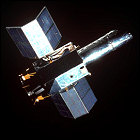 Launched in 1978 as a joint venture between NASA and ESA, the unmanned International Ultraviolet Explorer is commanded to exhaust its remaining fuel and cease all contact with Earth. Though its detectors and other instruments are still functioning well after 18 years in orbit, its stabilization gyros have failed one by one until the satellite is unable to be aimed at deep space targets with any accuracy. IUE remains powered down, adrift in a geosynchronous orbit.
Launched in 1978 as a joint venture between NASA and ESA, the unmanned International Ultraviolet Explorer is commanded to exhaust its remaining fuel and cease all contact with Earth. Though its detectors and other instruments are still functioning well after 18 years in orbit, its stabilization gyros have failed one by one until the satellite is unable to be aimed at deep space targets with any accuracy. IUE remains powered down, adrift in a geosynchronous orbit.

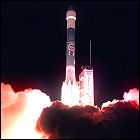 NASA/JPL’s low-cost
NASA/JPL’s low-cost 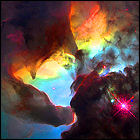 NASA’s Hubble Space Telescope does some interstellar storm spotting, capturing an image of funnel-cloud-shaped structures in the Lagoon Nebula, 5,000 light years away from Earth. Similar to the star-forming structures in the Eagle Nebula, the Lagoon Nebula’s star-birthing clouds are seen to be twisting into tornado-like shapes, possibly due to interactions of gases with extreme hot and cold temperatures, not unlike the weather processes leading to tornado formation on Earth.
NASA’s Hubble Space Telescope does some interstellar storm spotting, capturing an image of funnel-cloud-shaped structures in the Lagoon Nebula, 5,000 light years away from Earth. Similar to the star-forming structures in the Eagle Nebula, the Lagoon Nebula’s star-birthing clouds are seen to be twisting into tornado-like shapes, possibly due to interactions of gases with extreme hot and cold temperatures, not unlike the weather processes leading to tornado formation on Earth.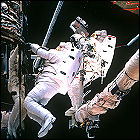 Space Shuttle Discovery lifts off on a ten-day mission to service the Hubble Space Telescope. Over 30 hours of spacewalks are conducted to repair and upgrade Hubble with new parts, and the shuttle engines are fired in short, steady bursts to raise the telescope’s orbit by over eight miles before it is released again. Aboard Discovery on her 22nd flight are Commander Kenneth Bowersox, Pilot Scott Horowitz, and mission specialists Mark Lee, Steven Hawley, Gregory Harbaugh, Steven Smith and Joseph Tanner.
Space Shuttle Discovery lifts off on a ten-day mission to service the Hubble Space Telescope. Over 30 hours of spacewalks are conducted to repair and upgrade Hubble with new parts, and the shuttle engines are fired in short, steady bursts to raise the telescope’s orbit by over eight miles before it is released again. Aboard Discovery on her 22nd flight are Commander Kenneth Bowersox, Pilot Scott Horowitz, and mission specialists Mark Lee, Steven Hawley, Gregory Harbaugh, Steven Smith and Joseph Tanner.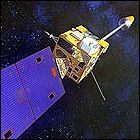 NOAA’s GOES-10 Geostationary Operational Environmental Satellite is launched from Cape Canaveral into a geosynchronous orbit to monitor weather patterns over the United States. GOES-10 suffers significant hardware issues upon reaching orbit, including the failure of sun-tracking sensors to orient its solar panels, and it will be over a year before it is pressed into operational service in the GOES-WEST orbit by the failure of GOES-9’s attitude control system. GOES-10 will operate there until 2006, when, upon the launch of GOES-11, it takes up a new position, GOES-SOUTH, monitoring South America and watching for Atlantic Ocean hurricane and tropical storm formation. It will be briefly moved back into the GOES-EAST orbit in late 2007, and with just enough maneuvering fuel left to boost it, it will finally be retired to the above-geostationary “graveyard” orbit in 2009.
NOAA’s GOES-10 Geostationary Operational Environmental Satellite is launched from Cape Canaveral into a geosynchronous orbit to monitor weather patterns over the United States. GOES-10 suffers significant hardware issues upon reaching orbit, including the failure of sun-tracking sensors to orient its solar panels, and it will be over a year before it is pressed into operational service in the GOES-WEST orbit by the failure of GOES-9’s attitude control system. GOES-10 will operate there until 2006, when, upon the launch of GOES-11, it takes up a new position, GOES-SOUTH, monitoring South America and watching for Atlantic Ocean hurricane and tropical storm formation. It will be briefly moved back into the GOES-EAST orbit in late 2007, and with just enough maneuvering fuel left to boost it, it will finally be retired to the above-geostationary “graveyard” orbit in 2009.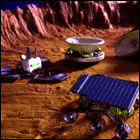 American toy company Mattel releases a
American toy company Mattel releases a 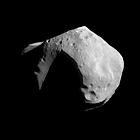 NASA’s NEAR (Near Earth Asteroid Rendezvous) unmanned spacecraft closes to within 750 miles of its first target, asteroid 253 Mathilde. Taking over 500 pictures of the asteroid and determining its mass and dimensions (roughly 31 miles in diameter). At the time of this flyby, Mathilde is the largest asteroid to be explored by a spacecraft. Discovered in 1885, Mathilde takes four years to orbit the sun within the main asteroid belt between Mars and Jupiter. NEAR Shoemaker moves on to its next destination, asteroid 433 Eros, which it is expected to reach in 1998.
NASA’s NEAR (Near Earth Asteroid Rendezvous) unmanned spacecraft closes to within 750 miles of its first target, asteroid 253 Mathilde. Taking over 500 pictures of the asteroid and determining its mass and dimensions (roughly 31 miles in diameter). At the time of this flyby, Mathilde is the largest asteroid to be explored by a spacecraft. Discovered in 1885, Mathilde takes four years to orbit the sun within the main asteroid belt between Mars and Jupiter. NEAR Shoemaker moves on to its next destination, asteroid 433 Eros, which it is expected to reach in 1998.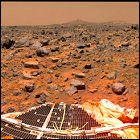 Using a never-before-attempted system of landing, the Mars Pathfinder unmanned probe employs an aerobraking maneuver to slow down in the planet’s atmosphere, and an all-encompassing layer of airbags to “bounce” onto the surface without using rockets to slow the vehicle down. The weighted landing station rolls to the correct orientation, deflates the airbags, and deploys on schedule, proving the merits of a landing technique that will deliver future Mars landers already in the planning stages.
Using a never-before-attempted system of landing, the Mars Pathfinder unmanned probe employs an aerobraking maneuver to slow down in the planet’s atmosphere, and an all-encompassing layer of airbags to “bounce” onto the surface without using rockets to slow the vehicle down. The weighted landing station rolls to the correct orientation, deflates the airbags, and deploys on schedule, proving the merits of a landing technique that will deliver future Mars landers already in the planning stages.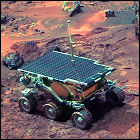 Sojourner, the original Mars rover, rides out on the Martian surface, getting close-up looks at nearby rocks and demonstrating technologies that are vital to upcoming Mars missions, including automatic hazard detection and avoidance. Sojourner’s ability to “see” obstacles and navigate around them without advice from ground controllers will be essential to later Mars rovers, since it takes seven minutes for a signal to reach Earth, and seven more minutes for instructions to return. The rover captures the public imagination and is even immortalized as a Hot Wheels toy.
Sojourner, the original Mars rover, rides out on the Martian surface, getting close-up looks at nearby rocks and demonstrating technologies that are vital to upcoming Mars missions, including automatic hazard detection and avoidance. Sojourner’s ability to “see” obstacles and navigate around them without advice from ground controllers will be essential to later Mars rovers, since it takes seven minutes for a signal to reach Earth, and seven more minutes for instructions to return. The rover captures the public imagination and is even immortalized as a Hot Wheels toy.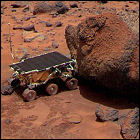 Its ability to recharge its power supply depleted, the
Its ability to recharge its power supply depleted, the 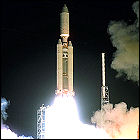 NASA/JPL’s interplanetary probe Cassini, with the European Space Agency-built Huygens Titan probe tagging along, lifts off on a Titan IV-B rocket. The voyage to Saturn will last seven years, during which Cassini does close flybys to receive gravity assists from Venus, Earth, Earth’s moon, and Jupiter en route to Saturn. It will operate in Saturn’s vicinity for over a decade and launch the Huygens probe, the first landing probe to visit a body in the outer solar system.
NASA/JPL’s interplanetary probe Cassini, with the European Space Agency-built Huygens Titan probe tagging along, lifts off on a Titan IV-B rocket. The voyage to Saturn will last seven years, during which Cassini does close flybys to receive gravity assists from Venus, Earth, Earth’s moon, and Jupiter en route to Saturn. It will operate in Saturn’s vicinity for over a decade and launch the Huygens probe, the first landing probe to visit a body in the outer solar system.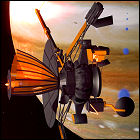 Beating the odds imposed upon it by the unforgiving environment around the planet Jupiter and its major moons, and engineering challenges such as a high-gain antenna that never unfurled properly after its 1989 launch, NASA’s Galileo space probe completes its two-year mission. Since the spacecraft is still intact and reasonably healthy, NASA gains a two-year extension, which it calls the Galileo Europa Mission, focusing on the two innermost large moons, icy Europa and volcanic Io. Trajectories are planned to fly Galileo even closer to these moons than ever before, though the harsh radiation zone around Jupiter itself could fry Galileo’s main computer and end the mission at any time.
Beating the odds imposed upon it by the unforgiving environment around the planet Jupiter and its major moons, and engineering challenges such as a high-gain antenna that never unfurled properly after its 1989 launch, NASA’s Galileo space probe completes its two-year mission. Since the spacecraft is still intact and reasonably healthy, NASA gains a two-year extension, which it calls the Galileo Europa Mission, focusing on the two innermost large moons, icy Europa and volcanic Io. Trajectories are planned to fly Galileo even closer to these moons than ever before, though the harsh radiation zone around Jupiter itself could fry Galileo’s main computer and end the mission at any time.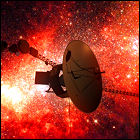 Unmanned space prove Voyager 1, launched in 1977, surpasses its forerunner Pioneer 10 as the furthest man-made object in space. Due to a sharp increase in its speed imparted by a very close pass by Saturn’s large moon Titan in 1980, Voyager 1 has outrun Pioneer 10, which was launched in 1972. Both vehicles are still returning science data, and Voyager 1 is now 6.5 billion miles from the sun, 70 times further out from the sun than Earth. Voyager’s on-board nuclear power source is expected to keep it active through 2020.
Unmanned space prove Voyager 1, launched in 1977, surpasses its forerunner Pioneer 10 as the furthest man-made object in space. Due to a sharp increase in its speed imparted by a very close pass by Saturn’s large moon Titan in 1980, Voyager 1 has outrun Pioneer 10, which was launched in 1972. Both vehicles are still returning science data, and Voyager 1 is now 6.5 billion miles from the sun, 70 times further out from the sun than Earth. Voyager’s on-board nuclear power source is expected to keep it active through 2020.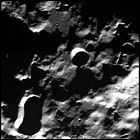 Though its extended mission was cut short by a mishap in 1994, NASA’s ill-fated Clementine lunar orbiter returned data with significant implications for further manned visits to the moon. NASA announces that craters near the north and south poles of Earth’s moon may harbor enough water ice to allow long-term colonization, and could also be used to create propellant on-site. While this promising announcement occurs as the 30th anniversary of the first manned moon landing approaches, any further manned visits exist strictly on paper.
Though its extended mission was cut short by a mishap in 1994, NASA’s ill-fated Clementine lunar orbiter returned data with significant implications for further manned visits to the moon. NASA announces that craters near the north and south poles of Earth’s moon may harbor enough water ice to allow long-term colonization, and could also be used to create propellant on-site. While this promising announcement occurs as the 30th anniversary of the first manned moon landing approaches, any further manned visits exist strictly on paper.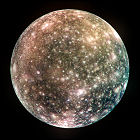 The unmanned NASA/JPL space probe Galileo makes a remarkable find at Callisto, the outermost of Jupiter’s four large “Galilean” moons: evidence that a saltwater ocean may lie beneath the moon’s pockmarked surface. Even more unusually, it may be the catalyst for Callisto’s magnetic field (a rarity for a satellite – not even all of the solar system’s planets have magnetic fields). Galileo’s instruments raise the possibility that the subsurface ocean may be conducting electricity and helping to generate that field (which current scientific models say Callisto should be too small to generate on its own). Scientists do not, however, believe that Callisto is a strong candidate to support life, unlike Europa.
The unmanned NASA/JPL space probe Galileo makes a remarkable find at Callisto, the outermost of Jupiter’s four large “Galilean” moons: evidence that a saltwater ocean may lie beneath the moon’s pockmarked surface. Even more unusually, it may be the catalyst for Callisto’s magnetic field (a rarity for a satellite – not even all of the solar system’s planets have magnetic fields). Galileo’s instruments raise the possibility that the subsurface ocean may be conducting electricity and helping to generate that field (which current scientific models say Callisto should be too small to generate on its own). Scientists do not, however, believe that Callisto is a strong candidate to support life, unlike Europa.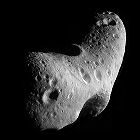 NASA’s unmanned NEAR (Near Earth Asteroid Rendezvous) unmanned space probe fails to fire its thrusters for a critical engine burn to keep it aimed at asteroid 433 Eros. The vehicle instead goes into an automatic safe mode and enters a tumble that drains both its batteries and its fuel supply to dangerously low levels, and it is out of contact with Earth for over a day. As a result, NEAR merely flies past Eros at a distance of almost 2400 miles, leaving ground controllers to devise a strategy to re-aim NEAR so it can catch up to and try once again to orbit the asteroid (the primary objective of its mission). This maneuver will take a year to complete.
NASA’s unmanned NEAR (Near Earth Asteroid Rendezvous) unmanned space probe fails to fire its thrusters for a critical engine burn to keep it aimed at asteroid 433 Eros. The vehicle instead goes into an automatic safe mode and enters a tumble that drains both its batteries and its fuel supply to dangerously low levels, and it is out of contact with Earth for over a day. As a result, NEAR merely flies past Eros at a distance of almost 2400 miles, leaving ground controllers to devise a strategy to re-aim NEAR so it can catch up to and try once again to orbit the asteroid (the primary objective of its mission). This maneuver will take a year to complete.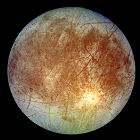 NASA scientists announce a startling find on one of Jupiter’s moons: a chemical which must be manufactured on Earth occurs naturally on the surface of Europa. The Galileo orbiter detects naturally-occurring hydrogren peroxide on the surface of the icy moon (a surface which most planetary scientists now believe covers an ocean of water or “slush” just beneath the crust), probably caused by the constant bombardment of radiation-charged particles from Jupiter itself. The hydrogen peroxide on Europa is also found to be very short-lived, quickly breaking down into gaseous oxygen and hydrogen.
NASA scientists announce a startling find on one of Jupiter’s moons: a chemical which must be manufactured on Earth occurs naturally on the surface of Europa. The Galileo orbiter detects naturally-occurring hydrogren peroxide on the surface of the icy moon (a surface which most planetary scientists now believe covers an ocean of water or “slush” just beneath the crust), probably caused by the constant bombardment of radiation-charged particles from Jupiter itself. The hydrogen peroxide on Europa is also found to be very short-lived, quickly breaking down into gaseous oxygen and hydrogen.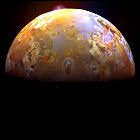 NASA/JPL’s unmanned Galileo space probe buzzes Jupiter’s volcanically active moon Io, zipping directly over one of its most active volcanic regions at an altitude of only 380 miles, Galileo’s closest Io flyby to date. But this close encounter, and the fate of Galileo itself, had been in doubt just hours before the flyby: entering Jupiter’s most intense radiation environment, Galileo had entered a failsafe mode in which the spacecraft shuts down until further commands are received from Earth. Ground controllers, called in to work emergency hours on a Sunday, revive Galileo a mere two hours before its close pass by Io.
NASA/JPL’s unmanned Galileo space probe buzzes Jupiter’s volcanically active moon Io, zipping directly over one of its most active volcanic regions at an altitude of only 380 miles, Galileo’s closest Io flyby to date. But this close encounter, and the fate of Galileo itself, had been in doubt just hours before the flyby: entering Jupiter’s most intense radiation environment, Galileo had entered a failsafe mode in which the spacecraft shuts down until further commands are received from Earth. Ground controllers, called in to work emergency hours on a Sunday, revive Galileo a mere two hours before its close pass by Io.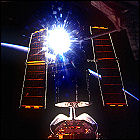 Space Shuttle Discovery lifts off on an eight-day mission to retrieve, service and redeploy the Hubble Space Telescope. This routine planned upgrade for Hubble sees the shuttle crew swapping out the $2,000,000,000 telescope’s CPU, installing a new one with 20 times the processing power of the original, during an eight-hour spacewalk; another eight-hour spacewalk sees crewmembers removing an analog data recorder to replace it with a digital device with greater capacity. Christmas 1999 is spent placing Hubble back into its orbit. Aboard Discovery for her 27th flight are Commander Curtis Brown, Pilot Scott Kelly, and mission specialists Steven Smith, Michael Foale, John Grunsfield, Claude Nicollier and Jean-Francois Clervoy.
Space Shuttle Discovery lifts off on an eight-day mission to retrieve, service and redeploy the Hubble Space Telescope. This routine planned upgrade for Hubble sees the shuttle crew swapping out the $2,000,000,000 telescope’s CPU, installing a new one with 20 times the processing power of the original, during an eight-hour spacewalk; another eight-hour spacewalk sees crewmembers removing an analog data recorder to replace it with a digital device with greater capacity. Christmas 1999 is spent placing Hubble back into its orbit. Aboard Discovery for her 27th flight are Commander Curtis Brown, Pilot Scott Kelly, and mission specialists Steven Smith, Michael Foale, John Grunsfield, Claude Nicollier and Jean-Francois Clervoy.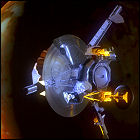 Completing its extended two-year tour of Jupiter and its intriguing moons Io and Europa, NASA’s Galileo robotic probe is given another extension, this time called the Galileo Millennium Mission. Highlights are expected to include observing Jupiter in tandem with the Cassini unmanned probe, which will swing by Jupiter in 2000 to gain a gravity assist en route to its own final target, Saturn. Galileo will also resume its exploration of the major Jovian moon Ganymede, the solar system’s largest satellite.
Completing its extended two-year tour of Jupiter and its intriguing moons Io and Europa, NASA’s Galileo robotic probe is given another extension, this time called the Galileo Millennium Mission. Highlights are expected to include observing Jupiter in tandem with the Cassini unmanned probe, which will swing by Jupiter in 2000 to gain a gravity assist en route to its own final target, Saturn. Galileo will also resume its exploration of the major Jovian moon Ganymede, the solar system’s largest satellite.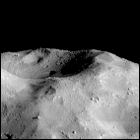 After orbiting the sun behind asteroid 433 Eros for a year since a failed thruster burn almost ended its mission, unmanned space probe NEAR (Near Earth Asteroid Rendezvous) fires its engines successfully, slowing itself to fall into orbit around Eros. During the weeks leading up to the orbital insertion maneuver, NEAR observed the space around Eros to ensure that no satellites existed with which it might collide. NEAR’s close study of Eros officially begins, and further maneuvers bring it into an ever-closer orbit around the asteroid.
After orbiting the sun behind asteroid 433 Eros for a year since a failed thruster burn almost ended its mission, unmanned space probe NEAR (Near Earth Asteroid Rendezvous) fires its engines successfully, slowing itself to fall into orbit around Eros. During the weeks leading up to the orbital insertion maneuver, NEAR observed the space around Eros to ensure that no satellites existed with which it might collide. NEAR’s close study of Eros officially begins, and further maneuvers bring it into an ever-closer orbit around the asteroid.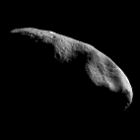 NASA’s NEAR (Near Earth Asteroid Rendezvous) unmanned spacecraft is officially renamed NEAR-Shoemaker, honoring Eugene Shoemaker, discoverer of multiple asteroids and comets, who died in 1997. Shoemaker had also put his geology skills to use in training Apollo astronauts after a medical diagnosis prevented him from joining the astronaut corps himself. NEAR-Shoemaker continues to orbit asteroid 433 Eros.
NASA’s NEAR (Near Earth Asteroid Rendezvous) unmanned spacecraft is officially renamed NEAR-Shoemaker, honoring Eugene Shoemaker, discoverer of multiple asteroids and comets, who died in 1997. Shoemaker had also put his geology skills to use in training Apollo astronauts after a medical diagnosis prevented him from joining the astronaut corps himself. NEAR-Shoemaker continues to orbit asteroid 433 Eros.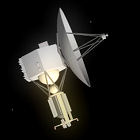 After four years of ballooning costs and launch weight, NASA brings work on the proposed Pluto-Kuiper Express mission to a stop, citing cost overruns and angering planetary scientists. The scientific community protests that, if a mission is not launched to reach Pluto by the year 2020, the tiny planet’s atmosphere will undergo a kind of reverse sublimation process, transitioning from a gas to a solid that rains down to Pluto’s surface. But with mission plans calling for a half-billion-dollar mission (originally budgeted for only $350 million), NASA pulls the plug, announcing that it will solicit new mission designs and plans from scientists around the world, even as advocates for the Pluto-Kuiper Express mission rally around the cancelled proposal.
After four years of ballooning costs and launch weight, NASA brings work on the proposed Pluto-Kuiper Express mission to a stop, citing cost overruns and angering planetary scientists. The scientific community protests that, if a mission is not launched to reach Pluto by the year 2020, the tiny planet’s atmosphere will undergo a kind of reverse sublimation process, transitioning from a gas to a solid that rains down to Pluto’s surface. But with mission plans calling for a half-billion-dollar mission (originally budgeted for only $350 million), NASA pulls the plug, announcing that it will solicit new mission designs and plans from scientists around the world, even as advocates for the Pluto-Kuiper Express mission rally around the cancelled proposal.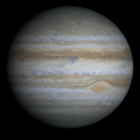 NASA’s Cassini space probe successfully completes a slingshot maneuver past Jupiter, a necessary milestone on the unmanned robot’s long journey to Saturn. While in the neighborhood, Cassini conducts tandem studies of Jupiter with the still-operational Galileo probe, which – despite numerous major malfunctions – has still survived three years longer in Jovian space than it was expected to. As large as Jupiter is, Cassini will still be lending its electronic eyes and ears to studies of the largest planet well into January. Cassini will reach Saturn’s neighborhood in 2004.
NASA’s Cassini space probe successfully completes a slingshot maneuver past Jupiter, a necessary milestone on the unmanned robot’s long journey to Saturn. While in the neighborhood, Cassini conducts tandem studies of Jupiter with the still-operational Galileo probe, which – despite numerous major malfunctions – has still survived three years longer in Jovian space than it was expected to. As large as Jupiter is, Cassini will still be lending its electronic eyes and ears to studies of the largest planet well into January. Cassini will reach Saturn’s neighborhood in 2004.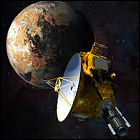 In response to a NASA request for mission proposals a month earlier, Southwest Research Institute scientist Dr. Alan Stern and a group of other scientists and engineers who had been working on the now-cancelled Pluto-Kuiper Express mission submit a nearly-identical proposal to NASA for a Pluto/Kuiper Belt mission called New Horizons. Very much like Pluto-Kuiper Express, New Horizons calls for a single small spacecraft to launch early in the 21st century, and, after a gravity assist from a Jupiter flyby, a Pluto encounter 10-11 years after launch. Some of the program costs are streamlined in the new proposal to make this iteration of the long-delayed Pluto mission more appealing to NASA, although New Horizons would carry more scientific payload than any previously envisioned Pluto expedition. Another proposal, Pluto and Outer Solar System Explorer (POSSE), is also submitted to NASA.
In response to a NASA request for mission proposals a month earlier, Southwest Research Institute scientist Dr. Alan Stern and a group of other scientists and engineers who had been working on the now-cancelled Pluto-Kuiper Express mission submit a nearly-identical proposal to NASA for a Pluto/Kuiper Belt mission called New Horizons. Very much like Pluto-Kuiper Express, New Horizons calls for a single small spacecraft to launch early in the 21st century, and, after a gravity assist from a Jupiter flyby, a Pluto encounter 10-11 years after launch. Some of the program costs are streamlined in the new proposal to make this iteration of the long-delayed Pluto mission more appealing to NASA, although New Horizons would carry more scientific payload than any previously envisioned Pluto expedition. Another proposal, Pluto and Outer Solar System Explorer (POSSE), is also submitted to NASA.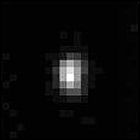 NASA releases a photo taken by the Cassini space probe as it passed by Jupiter and its complex system of satellites in December 2000, showing the first-ever view of the tiny moon Himalia, taken from a distance of 2.7 million miles. Non-spherical in shape, but estimated to be roughly 100 miles across its widest face, Himalia is believed to be an asteroid permanently captured into an inclined orbit of Jupiter. It was discovered in 1904 from Earth-based telescopes. The New Horizons space probe will also attempt to image Himalia in 2007. The sixth largest satellite of Jupiter, Himalia is the first of the planet’s outer satellites beyond the orbit of Callisto to be photographed by a passing spacecraft.
NASA releases a photo taken by the Cassini space probe as it passed by Jupiter and its complex system of satellites in December 2000, showing the first-ever view of the tiny moon Himalia, taken from a distance of 2.7 million miles. Non-spherical in shape, but estimated to be roughly 100 miles across its widest face, Himalia is believed to be an asteroid permanently captured into an inclined orbit of Jupiter. It was discovered in 1904 from Earth-based telescopes. The New Horizons space probe will also attempt to image Himalia in 2007. The sixth largest satellite of Jupiter, Himalia is the first of the planet’s outer satellites beyond the orbit of Callisto to be photographed by a passing spacecraft.